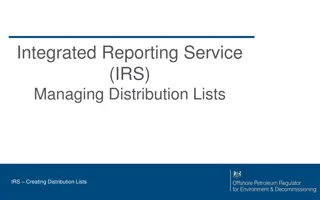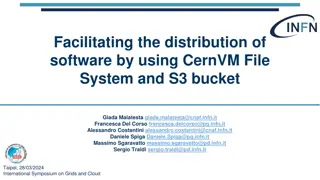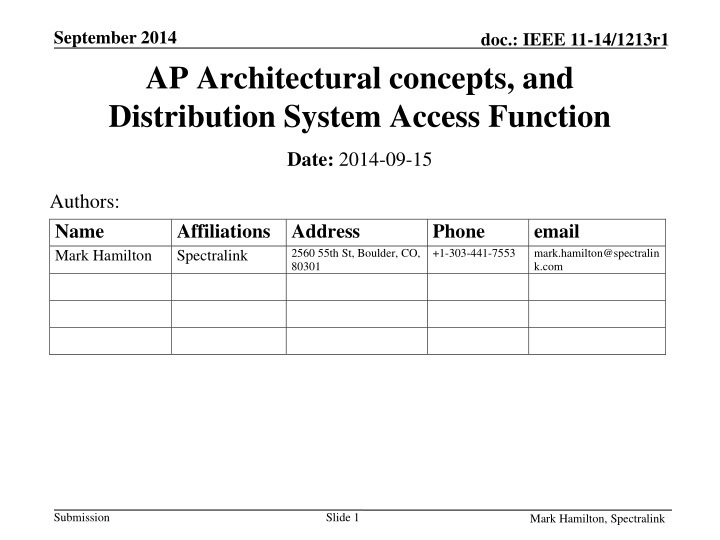
Architectural Concepts and Distribution System Access Function Proposal
"Explore the introduction of a new concept, the Distribution System Access Function (DSAF), within the context of IEEE standards. This proposal, presented by Mark Hamilton of Spectralink, delves into the architectural concepts and network layers involved, offering a fresh perspective on providing access beyond traditional services in network environments."
Download Presentation

Please find below an Image/Link to download the presentation.
The content on the website is provided AS IS for your information and personal use only. It may not be sold, licensed, or shared on other websites without obtaining consent from the author. If you encounter any issues during the download, it is possible that the publisher has removed the file from their server.
You are allowed to download the files provided on this website for personal or commercial use, subject to the condition that they are used lawfully. All files are the property of their respective owners.
The content on the website is provided AS IS for your information and personal use only. It may not be sold, licensed, or shared on other websites without obtaining consent from the author.
E N D
Presentation Transcript
September 2014 doc.: IEEE 11-14/1213r1 AP Architectural concepts, and Distribution System Access Function Date: 2014-09-15 Authors: Name Mark Hamilton Affiliations Address Spectralink Phone +1-303-441-7553 email mark.hamilton@spectralin k.com 2560 55th St, Boulder, CO, 80301 Submission Slide 1 Mark Hamilton, Spectralink
September 2014 doc.: IEEE 11-14/1213r1 Abstract Starting from the model presented in 11-14/497, a new concept called the Distribution System Access Function (DSAF) is proposed. Following, discussion is provided to start considering concepts from mesh and other relay/forwarding operations. - Note, the first three slides of this presentation are taken directly from 11-14/497r3. Thanks and credit to the original author of those slides (Norm Finn) Submission Slide 2 Mark Hamilton, Spectralink
September 2014 This is an example of a physical network doc.: IEEE 11-14/1213r1 802.3 802.3 AP 1 AP 2 Two physical boxes, commonly (but inaccurately) called APs, connected by an IEEE 802.3 link. Two clients of AP 1 shown, two wireless and one wired clients of AP 2 not shown. No VLANs. Submission Slide 3 Mark Hamilton, Spectralink
September 2014 Layering doc.: IEEE 11-14/1213r1 In the ISO layering model, a DATA.request is presented by a higher layer to a lower layer, and a DATA.indication is presented by a lower layer to a higher layer. In all further diagrams in this deck, the higher layer is closer to the top of the slide, and the lower layer closer to the bottom. Submission Slide 4 Mark Hamilton, Spectralink
September 2014 A standard view of that same network in 802.11 today doc.: IEEE 11-14/1213r1 AP* portal MAC PHY AP* MAC MAC MAC PHY MAC PHY Distribution System (DS) PHY PHY Non-AP STAs This is similar to IEEE 802.11-2012, Figure R-1, but drawn with request down indication up rigorously applied. The DS has three users, two APs and a portal, so is shown passing behind a MAC. 802.3 AP 2 AP 1 * Correctly, an AP is this component PLUS the STA (MAC and PHY); currently there is no name for this component Submission Slide 5 Mark Hamilton, Spectralink
September 2014 Proposal: Introduce the Distribution System Access Function doc.: IEEE 11-14/1213r1 * portal MAC PHY * MAC MAC MAC PHY MAC PHY Distribution System (DS) PHY PHY Non-AP STAs An access point (AP) is any entity that has STA functionality and enables access to the DS, via the WM for associated STAs. 802.3 AP 2 AP 1 So, the logical purpose of the * entity is to provide the services beyond the STA services (SSs) that are necessary to provide access to the DS. Thus, the proposed new term: Distribution System Access Function (DSAF) for this entity within an AP. So, we draw this as Submission Slide 6 Mark Hamilton, Spectralink
September 2014 Proposal: Introduce the Distribution System Access Function doc.: IEEE 11-14/1213r1 DSAF portal MAC PHY DSAF MAC MAC MAC PHY MAC PHY Distribution System (DS) PHY PHY Non-AP STAs 802.3 AP 1 AP 2 An AP comprises a STA and a DSAF. The DSAF is the entity within an AP that provides access to the distribution system for STAs associated to the AP. Propose to add definition(s) and text to 802.11 to reflect this concept. Submission Slide 7 Mark Hamilton, Spectralink
September 2014 doc.: IEEE 11-14/1213r1 Also, compare with Figure R-1 DSAF portal MAC PHY DSAF MAC MAC MAC PHY MAC PHY Distribution System (DS) PHY PHY Non-AP STAs 802.3 AP 1 AP 2 Propose redrawing R-1, like the above: - Up/down correct - AP (wrong) changed to DSAF - Need Mesh Gate (see next slide) Submission Slide 8 Mark Hamilton, Spectralink
September 2014 doc.: IEEE 11-14/1213r1 Mesh definitions are subtly different from AP s: mesh station (STA): A quality-of-service (QoS) STA that implements the mesh facility. mesh facility:The set of enhanced functions, channel access rules, frame formats, mutual authentication methods, and managed objects used to provide data transfer among autonomously operating stations (STAs). mesh gate: Any entity that has mesh station (STA) functionality and provides access to one or more distribution systems. Thus, mesh STAs provide the mesh facility (within the concept of mesh STA ) This is a problem for Figure 4-9, which shows a Mesh function above/outside the STA, as shown at the right: Submission Slide 9 Mark Hamilton, Spectralink
September 2014 doc.: IEEE 11-14/1213r1 Do we: Change (clarify?) mesh definitions to have a concept of the mesh facility outside/above the STA, similar to the DSAF? OR Change Figure 4-9 (and similar discussion in text and other figures) to show that a mesh STA is just a STA in a special mode (nothing external to the STA)? We re leaning toward the second choice. Once a direction is chosen, a mesh STA and mesh gate can be drawn in a similar fashion to the AP drawing, and the result can be considered to replace Figure R-1. Submission Slide 10 Mark Hamilton, Spectralink
September 2014 doc.: IEEE 11-14/1213r1 Next: Look at other relay type of functions (DMG RDS/REDS, DMG PCP forwarding, 11ah, ) Submission Slide 11 Mark Hamilton, Spectralink


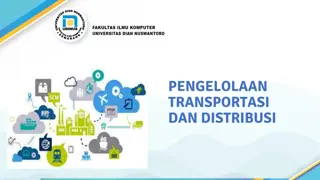
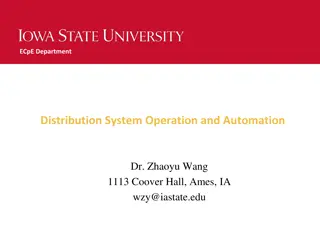


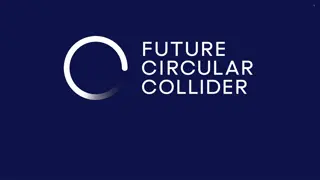
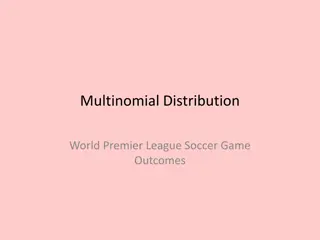
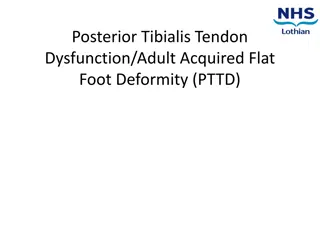

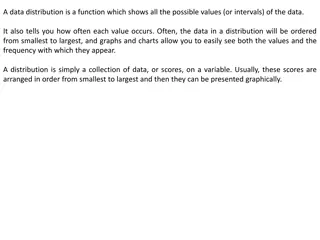
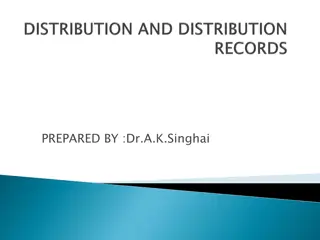
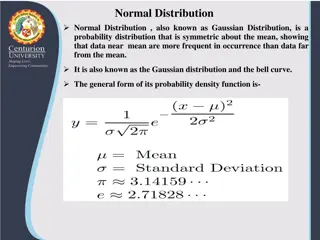
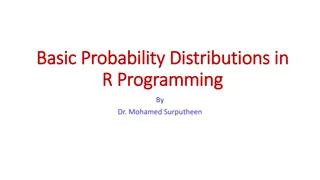

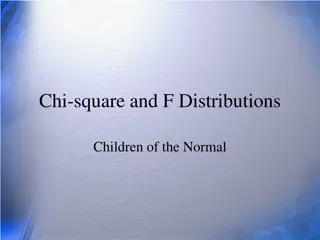
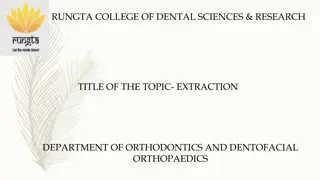
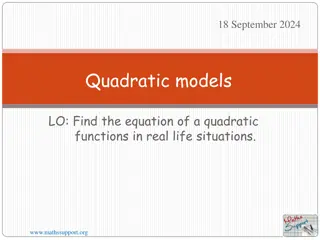
![Legal Dispute Analysis: FCA v ARCH and Others [2021] UKSC 1](/thumb/189783/legal-dispute-analysis-fca-v-arch-and-others-2021-uksc-1.jpg)


